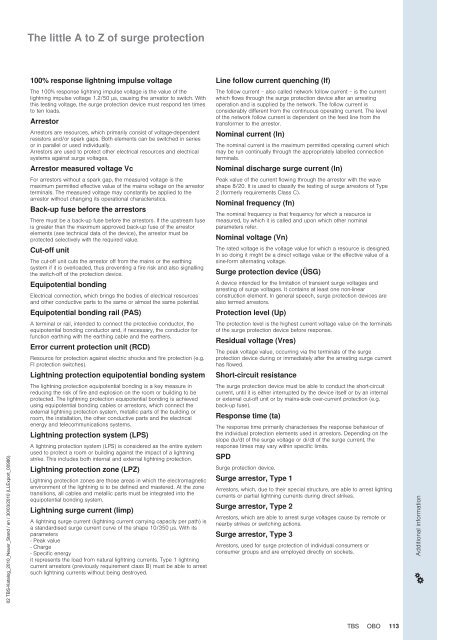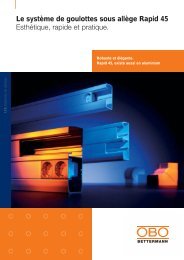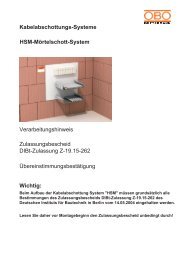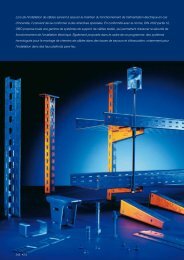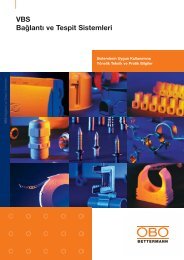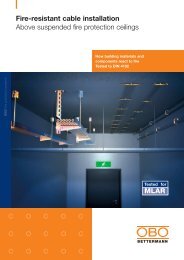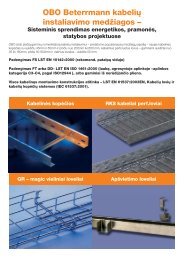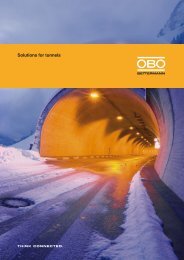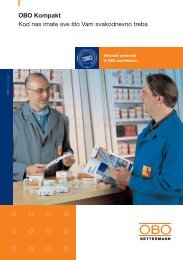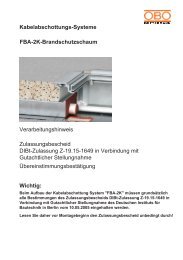Data and information technology - OBO Bettermann
Data and information technology - OBO Bettermann
Data and information technology - OBO Bettermann
You also want an ePaper? Increase the reach of your titles
YUMPU automatically turns print PDFs into web optimized ePapers that Google loves.
The little A to Z of surge protection100% response lightning impulse voltageLine follow current quenching (lf)The 100% response lightning impulse voltage is the value of thelightning impulse voltage 1.2/50 µs, causing the arrestor to switch. Withthis testing voltage, the surge protection device must respond ten timesto ten loads.ArrestorArrestors are resources, which primarily consist of voltage-dependentresistors <strong>and</strong>/or spark gaps. Both elements can be switched in seriesor in parallel or used individually.Arrestors are used to protect other electrical resources <strong>and</strong> electricalsystems against surge voltages.Arrestor measured voltage VcThe follow current − also called network follow current − is the currentwhich flows through the surge protection device after an arrestingoperation <strong>and</strong> is supplied by the network. The follow current isconsiderably different from the continuous operating current. The levelof the network follow current is dependent on the feed line from thetransformer to the arrestor.Nominal current (ln)The nominal current is the maximum permitted operating current whichmay be run continually through the appropriately labelled connectionterminals.Nominal discharge surge current (ln)For arrestors without a spark gap, the measured voltage is themaximum permitted effective value of the mains voltage on the arrestorterminals. The measured voltage may constantly be applied to thearrestor without changing its operational characteristics.Back-up fuse before the arrestorsThere must be a back-up fuse before the arrestors. If the upstream fuseis greater than the maximum approved back-up fuse of the arrestorelements (see technical data of the device), the arrestor must beprotected selectively with the required value.Cut-off unitThe cut-off unit cuts the arrestor off from the mains or the earthingsystem if it is overloaded, thus preventing a fire risk <strong>and</strong> also signallingthe switch-off of the protection device.Equipotential bondingElectrical connection, which brings the bodies of electrical resources<strong>and</strong> other conductive parts to the same or almost the same potential.Equipotential bonding rail (PAS)Peak value of the current flowing through the arrestor with the waveshape 8/20. It is used to classify the testing of surge arrestors of Type2 (formerly requirements Class C).Nominal frequency (fn)The nominal frequency is that frequency for which a resource ismeasured, by which it is called <strong>and</strong> upon which other nominalparameters refer.Nominal voltage (Vn)The rated voltage is the voltage value for which a resource is designed.In so doing it might be a direct voltage value or the effective value of asine-form alternating voltage.Surge protection device (ÜSG)A device intended for the limitation of transient surge voltages <strong>and</strong>arresting of surge voltages. It contains at least one non-linearconstruction element. In general speech, surge protection devices arealso termed arrestors.Protection level (Up)A terminal or rail, intended to connect the protective conductor, theequipotential bonding conductor <strong>and</strong>, if necessary, the conductor forfunction earthing with the earthing cable <strong>and</strong> the earthers.Error current protection unit (RCD)Resource for protection against electric shocks <strong>and</strong> fire protection (e.g.FI protection switches).Lightning protection equipotential bonding systemThe protection level is the highest current voltage value on the terminalsof the surge protection device before response.Residual voltage (Vres)The peak voltage value, occurring via the terminals of the surgeprotection device during or immediately after the arresting surge currenthas flowed.Short-circuit resistance02 TBS-Katalog_2010_Neuer_St<strong>and</strong> / en / 30/03/2010 (LLExport_00986)The lightning protection equipotential bonding is a key measure inreducing the risk of fire <strong>and</strong> explosion on the room or building to beprotected. The lightning protection equipotential bonding is achievedusing equipotential bonding cables or arrestors, which connect theexternal lightning protection system, metallic parts of the building orroom, the installation, the other conductive parts <strong>and</strong> the electricalenergy <strong>and</strong> telecommunications systems.Lightning protection system (LPS)A lightning protection system (LPS) is considered as the entire systemused to protect a room or building against the impact of a lightningstrike. This includes both internal <strong>and</strong> external lightning protection.Lightning protection zone (LPZ)Lightning protection zones are those areas in which the electromagneticenvironment of the lightning is to be defined <strong>and</strong> mastered. At the zonetransitions, all cables <strong>and</strong> metallic parts must be integrated into theequipotential bonding system.Lightning surge current (limp)A lightning surge current (lightning current carrying capacity per path) isa st<strong>and</strong>ardised surge current curve of the shape 10/350 µs. With itsparameters- Peak value- Charge- Specific energyit represents the load from natural lightning currents. Type 1 lightningcurrent arrestors (previously requirement class B) must be able to arrestsuch lightning currents without being destroyed.The surge protection device must be able to conduct the short-circuitcurrent, until it is either interrupted by the device itself or by an internalor external cut-off unit or by mains-side over-current protection (e.g.back-up fuse).Response time (ta)The response time primarily characterises the response behaviour ofthe individual protection elements used in arrestors. Depending on theslope du/dt of the surge voltage or di/dt of the surge current, theresponse times may vary within specific limits.SPDSurge protection device.Surge arrestor, Type 1Arrestors, which, due to their special structure, are able to arrest lightingcurrents or partial lightning currents during direct strikes.Surge arrestor, Type 2Arrestors, which are able to arrest surge voltages cause by remote ornearby strikes or switching actions.Surge arrestor, Type 3Arrestors, used for surge protection of individual consumers orconsumer groups <strong>and</strong> are employed directly on sockets.Additional <strong>information</strong>TBS<strong>OBO</strong>113


